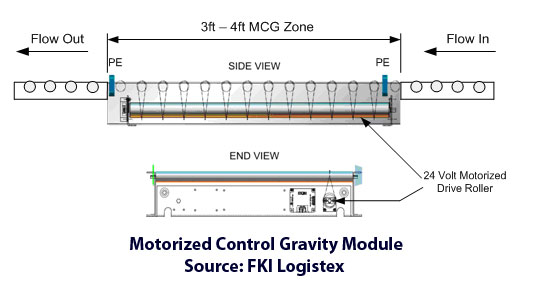A few conveyor manufacturers have recently developed what could be considered a “hybrid” solution, meaning that it uses a small amount of electricity. Referred to as Motorized Control Gravity (MCG), it’s intended for use in shipping line conveyors to transport cases from the shipping sorter to the dock for palletizing or fluid trailer loading applications.

How it Works
In a pitched gravity roller shipping line that is 60 to 80 feet long (for example), there would be 3 to 4 MCG Modules, as illustrated above. Each module would have a powered roller bed zone that is 3 to 4 ft long. A 24-volt motor and gear box assembly is inserted inside the drive roller (like a ship in a bottle). As a case enters a zone and trips the photo-eye (PE) on the in-feed end of the zone, the 24-volt motorized drive roller is de-energized for a specified time delay (about 2 or 3 seconds), which causes a temporary braking action of the carrying rollers. After the time delay expires, and the PE on the discharge end of the zone is clear, the drive roller is re-energized and the case is released to the next MCG located about 20 feet downstream.
However, if the PE on the discharge end of the zone is blocked when a case trips the in-feed PE, the drive roller remains de-energized, stopping case flow thru the zone. When the discharge PE is clear, flow resumes.
Problem Solved
The accumulated backpressure is limited to the distance between the gravity control flow modules – about 20 feet. In this way, all of the various size and weight cases will flow smoothly from MCG to MCG down the shipping line.
In many system applications, MDR technology has the potential to save costs on the shipping dock by replacing decline belt and zero-pressure accumulation conveyors with Motorized Control Flow Gravity, while at the same time reducing energy consumption.
So, with a little creative thought and innovation, adding Motorized Control Flow Gravity to your material handling system becomes a low-cost, Green alternative worth considering.
Do you think this hybrid gravity conveyor is a good one for DC applications? Where are the best fits? Let us know your thoughts at the Feedback button below.
|